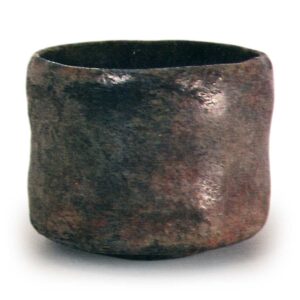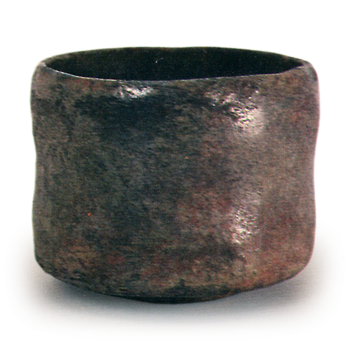
Founder of Raku ware. His name is Chojiro, also known as Chojiro or Asajiro. His family name was Sasaki at first, but later he was given Rikyu’s first family name “Tanaka” by Sen no Rikyu, and took the name Tanaka Chojiro. He was given a gold seal with the character “Raku” by Hideyoshi, and was regarded as the founder of Raku ware and the first generation of the Raku family.
According to a common belief, his father was a naturalized citizen named Aumeya (Sokei), who was born in Kyoto in 1516. He mastered the art of pottery and his products were called Kyo-yaki or Ima-yaki. In 1574, he fired roof tiles at the order of Oda Nobunaga, and in 1585, when Toyotomi Hideyoshi began construction of the Jurakudai, he is said to have fired the decorative parts of the roof tiles. It is also said that in 1577, under the guidance of Rikyu, he fired red and black tea bowls and presented them to Nobunaga. Later, he began to produce pottery in Jurakudai as an official potter under the direction of Rikyu, and his reputation grew considerably. Hideyoshi granted him the title of “the best in the country” and bestowed upon him a gold seal with the character “Raku” on it. From this time on, Chojiro’s work came to be known as “Juraku ware” or simply “Raku ware. However, there are various theories about this. Some say that the gold seal was given by Tsunekei II, and that the name Raku-yaki was commonly used from the time of the second generation. There are also several theories about how Chojiro developed the unique ceramic technique of Raku ware. There is also a theory that he acquired the pottery method in Ming China. Another theory suggests that he went to Choryangjin in Korea to learn the Dharma of the Black Goryeo Dynasty. However, there is no solid evidence for either of these theories. In short, the Raku ware created by Chojiro was requested by the tea ceremony, which developed uniquely in Japan, and its direct supporter and leader was Sen no Rikyu, the founder of the tea ceremony. Rikyu was the direct patron and leader of Raku ware, and the origin of the ceramic art of Raku ware cannot be considered without Rikyu’s support. He died in 1589. Dharma name: Saishoin Chosyu Nichigen.
According to another version, he was 47 years old.
The tea bowls of Chojiro are often small and rarely large, which is the result of Rikyu’s preference for small bowls for his Souan Wabicha (hermitage Wabi-tea). Some Chojiro pieces have brownish tones in the black glaze, some have white glaze floating in the red glaze, and some have a kind of unique glaze quality that cannot be duplicated by others. The description “At first, the shape of the ware was aimed at the Korean wares of Ido, Kumagawa, Tamagote, Irabo, etc., but it gradually developed a kind of ingenuity and finally opened the gate to the first-class Raku ware in Japan, In terms of technique and workmanship, it is said that the kiln technique was almost exclusively hand-kneaded, without the use of a potter’s wheel, and that each piece was fired one at a time in a small, swinging kiln or bellows, which could also be called a private kiln. There are two opinions: one says that they were fired at low heat and left to cool, and the other says that they were made with scissors. The bowls that are considered to have been left to cool are naturally covered with ash and have no luster on the glaze surface. If the bowl is ever replaced by fire, it will be grayish-white in color. Therefore, the yuzu skin on the surface of the bowl also appears naturally, and it is almost impossible to recognize the luster when compared to the later ones. The red color of the ware is fired in a brownish-brown or light-white style due to the fire color. The clay used for the bowl came from the Okazaki area, and the black material for the overglaze was black stone, commonly called “makuro,” found on the riverbank between Shijo and Gojo.
In addition to red and black glazes, there are also white glazes floating on the surface. The mouths are often hollowed out inward in a clam-tooth shape, and the bodies are often constricted. The body of most of them has a narrow base. Most of them have a low base, and the height of the base is rich in natural beauty without any technique. In addition, all tea tamari are often deeply gouged. In a word, it can be said to be elegant and to contain infinite elegance. In addition to the world-famous Chojiro seven kinds (Rikyu seven kinds) of tea bowls and Shigumi seven kinds of tea bowls, there are 43 bowls other than the above in “Kokin Meibutsu Ruju”, 23 bowls other than the above in “Taisho Meiki Kan” (6 of which were named by Rikyu), and many others that appeared in “Raku ware” and “Chado”. Other than tea bowls, other works include a lion’s head tile with the inscription “Tensho Nijun Yoritaimei Chozugi Ryo Zukuri”, a flat bowl in the katigi style, a water jar with the inscription “Tenka Ichiraku Chozugiro”, and a gunrkan.


